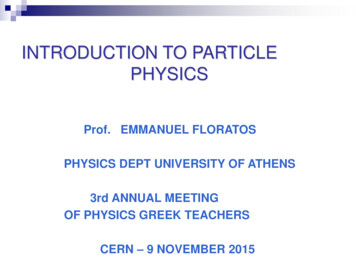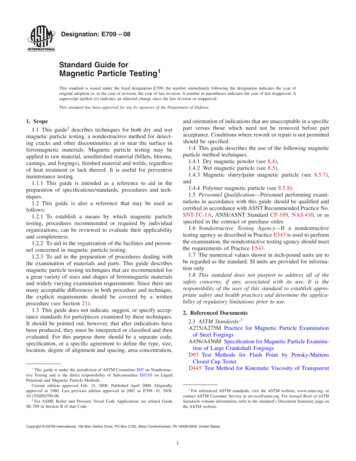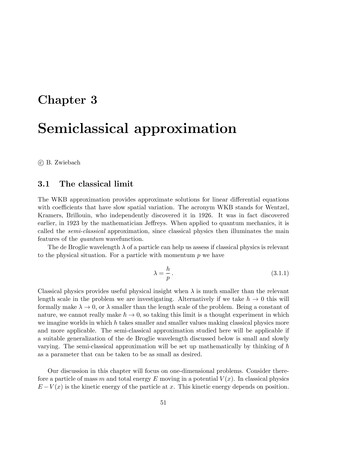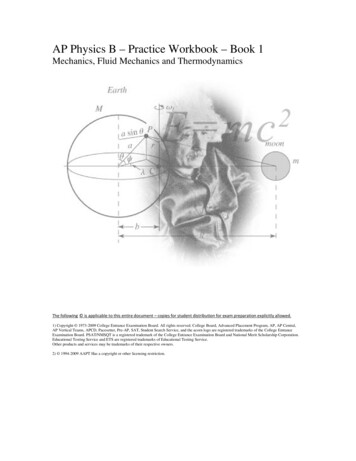
Transcription
INTRODUCTION TO PARTICLEPHYSICSProf. EMMANUEL FLORATOSPHYSICS DEPT UNIVERSITY OF ATHENS3rd ANNUAL MEETINGOF PHYSICS GREEK TEACHERSCERN – 9 NOVEMBER 2015
Web resources http://particleadventure.org/index.html http://quarknet.fnal.gov/ Especially designed for a very wide audienceA lot of links from this web page –please try as many as you canAgain, a lot of links from this web page – to modern experiments,and to more practical materialshttp://eddata.fnal.gov/lasso/quarknet g activities/detail.lasso?ID 18 This is specific link from the previous web page that I consideras a most important for implementation of an information aboutparticle physics into your sillabus
What is particle physics or HEP? Particle physics is a branch of physics that studies the elementaryconstituents of matter and radiation, and the interactions betweenthem. It is also called "high energy physics", because manyelementary particles do not occur under normal circumstances innature, but can be created and detected during energetic collisionsof other particles, as is done in particle acceleratorsParticle physics is a journey into the heart of matter.Everything in the universe, from stars and planets, to us is madefrom the same basic building blocks - particles of matter.Some particles were last seen only billionths of a second after theBig Bang. Others form most of the matter around us today.Particle physics studies these very small building block particles andworks out how they interact to make the universe look and behavethe way it does
What is the universe made of? A very old question, and one that has been approached inmany waysThe only reliable way to answer this question is by directlyenquiring of nature, through experiments not necessarily a “natural human activity”, but perhaps the greatesthuman inventionWhile it is often claimed that humans display a naturalcuriosity, this does not always seem to translate into anatural affinity for an experimental approach Despite hundreds of years of experience, science is notunderstood, and not particularly liked, by many peopleoften tolerated mainly because it is usefulSomething to think about, especially when we are trying to explainscientific projects that do not, a priori, seem to be useful
Experiment has taught us: Complex structures in the universe are made bycombining simple objects in different ways Apparently diverse phenomena are often differentmanifestations of the same underlying physics Orbits of planets and apples falling from treesAlmost everything is made of small objects that liketo stick together Periodic TableParticles and ForcesEveryday intuition is not necessarily a good guide We live in a quantum world, even if it’s not obvious to us
History of the particle physics Modern particle physics began in the early 20th centuryas an exploration into the structure of the atom. Thediscovery of the atomic nucleus in the gold foilexperiment of Geiger, Marsden, and Rutherford was thefoundation of the field. The components of the nucleuswere subsequently discovered in 1919 (the proton) and1932 (the neutron). In the 1920s the field of quantumphysics was developed to explain the structure of theatom. The binding of the nucleus could not beunderstood by the physical laws known at the time.Based on electromagnetism alone, one would expectthe protons to repel each other. In the mid-1930s,Yukawa proposed a new force to hold the nucleustogether, which would eventually become known as thestrong nuclear force. He speculated that this force wasmediated by a new particle called a meson.
Search for fundamental particles Also in the 1930s, Fermi postulated the neutrino as anexplanation for the observed energy spectrum of βdecay, and proposed an effective theory of the weakforce. Separately, the positron and the muon werediscovered by Anderson. Yukawa's meson wasdiscovered in the form of the pion in 1947. Over time, thefocus of the field shifted from understanding the nucleusto the more fundamental particles and their interactions,and particle physics became a distinct field from nuclearphysics.Throughout the 1950-1960’s, a huge variety of additionalparticles was found in scattering experiments. This wasreferred to as the "particle zoo".
Are protons and neutrons fundamental? To escape the "Particle Zoo," the next logical step was to investigatewhether these patterns could be explained by postulating that allBaryons and Mesons are made of other particles. These particleswere named Quarks As far as we know, quarks are like points in geometry.They're not made up of anything else.After extensively testing this theory, scientists nowsuspect that quarks and the electron (and a fewother things we'll see in a minute) are fundamental.An elementary particle or fundamental particle is aparticle not known to have substructure; that is, it is notknown to be made up of smaller particles. If anelementary particle truly has no substructure, then it isone of the basic particles of the universe from which alllarger particles are made.
Scale of the atom While an atom is tiny, the nucleus is tenthousand times smaller than the atom andthe quarks and electrons are at least tenthousand times smaller than that. We don'tknow exactly how small quarks andelectrons are; they are definitely smallerthan 10-18 meters, and they might literally bepoints, but we do not know.It is also possible that quarks and electronsare not fundamental after all, and will turnout to be made up of other, morefundamental particles.
Fundamental blocks Two types of point like constituentsLeptonse 1 2 3QuarksuctdsbPlus force carriers (will come to them later)For every type of matter particle we've found, there alsoexists a corresponding antimatter particle, orantiparticle.Antiparticles look and behave just like theircorresponding matter particles, except they haveopposite charges.
Generations of quarks and leptons Note that both quarks and leptons exist inthree distinct sets. Each set of quark andlepton charge types is called a generationof matter (charges 2/3, -1/3, 0, and -1 asyou go down each generation). Thegenerations are organized by increasingmass.All visible matter in the universe is madefrom the first generation of matter particles - up quarks, down quarks, and electrons.This is because all second and thirdgeneration particles are unstable andquickly decay into stable first generationparticles.
Spin: a property of particle Spin is a value of angular momentum assigned to allparticles. When a top spins, it has a certain amount ofangular momentum. The faster it spins, the greater theangular momentum. This idea of angular momentum isalso applied to particles, but it appeared to be anintrinsic, unchangeable property. For example, anelectron has and will always have 1/2 of spin.In quantum theories, angular momentum is measured inunits of h h/2p 1.05 x 10-34 Js (Max Planck). (Js isjoule-seconds, and is pronounced "h bar.")Classification of particles according to spin: Fermions: have spin ½Bosons: : have spin 1Scalar particles: have spin 0
Quarks Most of the matter we see around us is made fromprotons and neutrons, which are composed of up anddown quarks.There are six quarks, but physicists usually talk aboutthem in terms of three pairs: up/down, charm/strange,and top/bottom. (Also, for each of these quarks, there isa corresponding antiquark.)Quarks have the unusual characteristic of having afractional electric charge, unlike the proton and electron,which have integer charges of 1 and -1 respectively.Quarks also carry another type of charge called colorcharge, which we will discuss later.
Quantum numbers of quarksType of quarkChargeSpinu (up) 2/31/2d (down)-1/31/2s (strange), S 1-1/31/2c (charm), C 1 2/31/2b (bottom), B 1-1/31/2t (top) 2/31/2
Fractional charges and unseen quarks Murray Gell-Mann and George Zwieg proposed the idea ofthe quarks to find some order in the chaos of particles: baryons are particles consisting of three quarks (qqq),mesons are particles consisting of a quark and anti-quark (q q-bar).qqqQSBar.qqbarQSMes.uuu20Δ uubar00 0uud10Δ udbar10 udd00Δ0ubar d-10 -ddd-10Δ-ddbar00ηuus1-1K uus1-1Σ* s0-2K0dss-1-2Ξ*0dss-1-2η’-3Ω-sss-1
Fractional charges and unseen quarks Problems arose with introducing quarks: Fractional charge – never seen beforeQuarks are not observableNot all quark combinations exist in natureIt appears to violate the Pauli exclusion principle Originally was formulated for two electrons.Later realized that the same rule applies to all particles with spin ½.Consider D (uuu): is supposed to consist of three u quarks in thesame state – inconsistent with Pauli principle!
Color charge of quarks (1) So one had to explain why one saw only thosecombinations of quarks and antiquarks that had integercharge, and why no one ever saw a q, qq, qqqbar, orcountless other combinations. Gell-Mann and others thought that the answer had to liein the nature of forces between quarks. This force is theso-called "strong" force, and the new charges that feelthe force are called "color" charges, even though theyhave nothing to do with ordinary colors.
Color charge of quarks (2) They proposed that quarks can have three colorcharges. This type of charge was called "color" becausecertain combinations of quark colors would be "neutral"in the sense that three ordinary colors can yield white, aneutral color.Only particles that are color neutral can exist, which iswhy only qqq and q q-bar are seen.This also resolve a problem with Pauli principleJust like the combination of red and blue givespurple, the combination of certain colorsgive white. One example is the combination ofred, green and blue.
Summary of L.1 There are 6 quarks and 6 leptons which we believeare fundamental blocks of natureThey have antiparticles, i.e. the same quantumnumbers except electric chargeQuarks have fractional electric chargesA new charge for quarks has been introduced: thischarge is color
ForcesAlthough there are apparently many types of forces in theUniverse, they are all based on four fundamental forces:Gravity, Electromagnetic force, Weak force and Strong force.The strong and weak forces only act at very short distances andare responsible for holding nuclei together.The electromagnetic force acts between electric charges.The gravitational force acts between masses.Pauli's exclusion principle is responsible for the tendency ofatoms not to overlap each other, and is thus responsible for the"stiffness" or "rigidness" of matter, but this also depends on theelectromagnetic force which binds the constituents of everyatom.
ForcesAll other forces are based on these four. For example,friction is a manifestation of the electromagnetic forceacting between the atoms of two surfaces, and the Pauliexclusion principle, which does not allow atoms to passthrough each other.The forces in springs modeled by Hooke’s law are also theresult of electromagnetic forces and the exclusion principleacting together to return the object to its equilibriumposition.Centrifugal forces are acceleration forces which arisesimply from the acceleration of rotating frames of reference
Forces at the fundamental level The particles (quarks and leptons) interact throughdifferent “forces”, which we understand as due to theexchange of “field quanta” known as “gauge bosons”.Electromagnetism (QED) Photon (γ) exchangeStrong interactions (QCD) Gluon (g) exchangeWeak interactionsW and Z bosons exchangeGravitational interactions Graviton (G) exchange ?
Forces The Standard Model describes the interaction of quarks and leptonsvia these gauge bosons.There is also postulated but not yet discovered scalar (i.e. spin ofthis particle 0)What's the difference between a force and an interaction? This is a hard distinction to make. Strictly speaking, a force is theeffect on a particle due to the presence of other particles. Theinteractions of a particle include all the forces that affect it, butalso include decays and annihilations that the particle might gothrough. (We will spend the next chapter discussing thesedecays and annihilations in more depth.) The reason this gets confusing is that most people, even mostphysicists, usually use "force" and "interaction" interchangeably,although "interaction" is more correct. For instance, we call theparticles which carry the interactions force carrier particles. Youwill usually be okay using the terms interchangeably, but youshould know that they are different.
Exchange forces You can think about forces as being analogous to the followingsituation: Two people are standing in boats. One person moves their arm andis pushed backwards; a moment later the other person grabs at aninvisible object and is driven backwards. Even though you cannotsee a basketball, you can assume that one person threw abasketball to the other person because you see its effect on thepeople.It turns out that all interactions which affect matter particles are dueto an exchange of force carrier particles, a different type of particlealtogether. These particles are like basketballs tossed betweenmatter particles (which are like the basketball players). What wenormally think of as "forces" are actually the effects of force carrierparticles on matter particles.
Exchange forces We see examples of attractive forces in everyday life (such asmagnets and gravity), and so we generally take it for granted that anobject's presence can just affect another object. It is when weapproach the deeper question, "How can two objects affect oneanother without touching?" that we propose that the invisible forcecould be an exchange of force carrier particles. Particle physicistshave found that we can explain the force of one particle acting onanother to INCREDIBLE precision by the exchange of these forcecarrier particles.One important thing to know about force carriers is that a particularforce carrier particle can only be absorbed or produced by a matterparticle which is affected by that particular force. For instance,electrons and protons have electric charge, so they can produce andabsorb the electromagnetic force carrier, the photon. Neutrinos, onthe other hand, have no electric charge, so they cannot absorb orproduce photons.
Range of forcesThe range of forces is related to the mass of exchange particle M.An amount of energy ΔE Mc2 borrowed for a time Δt is governedby the Uncertainty Principle:DE Dt The maximum distance the particle can travel is Δx c Δt, where cis velocity of light.Dx c / DEDx c / Mc 2The photon has M 0 infinite range of EM force.W boson has a mass of 80 GeV/c2 Range of weak force is197 MeV fm/ 8x105 MeV 2x10-3 fm
Which forces act on which particles? The weak force acts between all quarks and leptonsThe electromagnetic force acts between all chargedparticlesThe strong force acts between all quarks (i.e. objectsthat have color charge)Gravity does not play any role in particle physicsWeakEMStrongQuarks Charged leptons –Neutral leptons ––
Electromagnetism The electromagnetic force causes like-charged things torepel and oppositely-charged things to attract. Manyeveryday forces, such as friction, are caused by theelectromagnetic, or E-M force. For instance, the force thatkeeps us from falling through the floor is theelectromagnetic force which causes the atoms making upthe matter in our feet and the floor to resist beingdisplaced. Photons of different energies span the electromagneticspectrum of x rays, visible light, radio waves, and so forth.
Residual EM force Atoms usually have the same numbers of protons andelectrons. They are electrically neutral, because the positiveprotons cancel out the negative electrons. Since they areneutral, what causes them to stick together to form stablemolecules?The answer is a bit strange: we've discovered that the chargedparts of one atom can interact with the charged parts of anotheratom. This allows different atoms to bind together, an effectcalled the residual electromagnetic force.So the electromagnetic force is whatallows atoms to bond and formmolecules, allowing the world to staytogether and create the matter. All thestructures of the world exist simplybecause protons and electrons haveopposite charges!
What about nucleus? We have another problem with atoms, though. Whatbinds the nucleus together?The nucleus of an atom consists of a bunch of protonsand neutrons crammed together. Since neutrons have nocharge and the positively-charged protons repel oneanother, why doesn't the nucleus blow apart?We cannot account for the nucleus staying together withjust electromagnetic force. What else could there be?
Strong interactions To understand what is happening inside the nucleus, we need tounderstand more about the quarks that make up the protons andneutrons in the nucleus. Quarks have electromagnetic charge, andthey also have an altogether different kind of charge called colorcharge. The force between color-charged particles is very strong, sothis force is "creatively" called strong.The strong force holds quarks together to form hadrons, so itscarrier particles are whimsically called gluons because they sotightly "glue" quarks together.Color charge behaves differently than electromagnetic charge.Gluons, themselves, have color charge, which is weird and not at alllike photons which do not have electromagnetic charge. And whilequarks have color charge, composite particles made out of quarkshave no net color charge (they are color neutral). For this reason,the strong force only takes place on the really small level of quarkinteractions.
Color charge There are three color charges and three corresponding anticolor(complementary color) charges. Each quark has one of the threecolor charges and each antiquark has one of the three anticolorcharges. Just as a mix of red, green, and blue light yields white light,in a baryon a combination of "red," "green," and "blue" color chargesis color neutral, and in an antibaryon "antired," "antigreen," and"antiblue" is also color neutral. Mesons are color neutral becausethey carry combinations such as "red" and "antired.“Because gluon-emission and -absorption always changes color, and-in addition - color is a conserved quantity - gluons can be thought ofas carrying a color and an anticolor charge. Since there are ninepossible color-anticolor combinations we might expect nine differentgluon charges, but the mathematics works out such that there areonly eight combinations. Unfortunately, there is no intuitiveexplanation for this result.
Color charge (2) When two quarks are close to one another, theyexchange gluons and create a very strong color forcefield that binds the quarks together. The force field getsstronger as the quarks get further apart. Quarksconstantly change their color charges as they exchangegluons with other quarks.qgqAnti-red-green gluon transforms thered quark into the green quark
Quark Confinement Color confinement is the physics phenomenon that color chargedparticles like quarks cannot be isolated. Quarks are confined with otherquarks by the strong interaction to form pairs of triplets so the net coloris neutral. The force between quarks increases as the distancebetween them increases, so no quarks can be found individually. As any of two electrically-charged particles separate, the electricfields between them diminish quickly, allowing electrons to becomeunbound from nuclei. However, as two quarks separate, the gluon fields form narrowtubes (or strings) of color charge) – quite different from EM! Because of this behavior, the color force experienced by the quarksin the direction to hold them together, remains constant, regardlessof their distance from each other. Since energy is calculated as force times distance, the totalenergy increases linearly with distance.
Quark Confinement (2) When two quarks become separated, as happens in acceleratorcollisions, at some point it is more energetically favorable for a newquark/anti-quark pair to "pop" out of the vacuum. In so doing, energy is conserved because the energy of the colorforce field is converted into the mass of the new quarks, and thecolor-force field can "relax" back to an unstretched state.
Residual strong force So now we know that the strong force binds quarks together becausequarks have color charge. But that still does not explain what holdsthe nucleus together, since positive protons repel each other withelectromagnetic force, and protons and neutrons are color-neutral.The answer is that, in short, they don't call it the strong force fornothing. The strong force between the quarks in one proton and thequarks in another proton is strong enough to overwhelm the repulsiveelectromagnetic forceThis is called the residual strong interaction, and it is what "glues" thenucleus
Weak interactions There are six kinds of quarks and six kinds of leptons.But all the stable matter of the universe appears to bemade of just the two least-massive quarks (up quark anddown quark), the least-massive charged lepton (theelectron), and the neutrinos.It is the only interaction capable of changing flavor.It is mediated by heavy gauge bosons W and Z. Due to the large mass of the weak interaction's carrier particles(about 90 GeV/c2), their mean life is limited to 3x10-25 s by theUncertainty principle. This effectively limits the range of weakinteraction to 10-18 m (1000 times smaller than the diameter of anatomic nucleus)It is the only force affecting neutrinos.
Weak interactions (2) Since the weak interaction is both very weak and veryshort range, its most noticeable effect is due to its otherunique feature: flavor changing.Consider a neutron n(udd) b-decay.Although the neutron is heavier thanits sister proton p(uud), it cannotdecay to proton without changing theflavor of one of its down quarks d.Neither EM nor strong interactionsallow to change the flavor changing,so that must proceed through weakinteraction.Here d u W u e en p e e
Gravity Gravitons are postulated because of the great successof the quantum field theory at modeling the behavior ofall other forces of nature with similar particles: EM withthe photon, the strong interaction with the gluons, andthe weak interaction with the W and Z bosons. In thisframework, the gravitational interaction is mediated bygravitons, instead of being described in terms of curvedspacetime like in general relativity.Gravitons should be massless since the gravitationalforce acts on infinite distances.Gravitons should have spin 2 (because gravity is asecond-rank tensor field)Gravitons have not been observed so far.For particle physics, it is very weak interaction to worryabout.
Introduction One of the most striking general properties of elementaryparticles is their tendency to disintegrate.Universal principle: Every particle decays into lighterparticles, unless prevented from doing so by someconservation law.Obvious conservation laws: Momentum conservationEnergy conservationCharge conservationStable particles: neutrinos, photon, electron and proton. Neutrinos and photon are massless, there is nothing to decay forthem intoThe electron is lightest charged particle, so conservation ofcharge prevents its decay.Why proton is stable?
Baryon number Baryon number: B ( n q n q ) 3all baryons have baryon number 1, and antibaryons have baryonnumber -1. The baryon number is conserved in all interactions,i.e. the sum of the baryon number of all incoming particles is thesame as the sum of the baryon numbers of all particles resultingfrom the reaction.For example, the process p e does not violate theconservation laws of charge, energy, linear momentum, or angularmomentum. However, it does not occur because it violates theconservation of baryon number, i.e., B 1 on the left and 0 on theright. It is fortunate that this process "never" happens, sinceotherwise all protons in the universe would gradually change intopositrons! The apparent stability of the proton, and the lack ofmany other processes that might otherwise occur, are thuscorrectly described by introducing the baryon number B togetherwith a law of conservation of baryon number.However, having stated that protons do not decay, it must also benoted that supersymmetric theories predict that protons actually dodecay, although with a half-life of at least 1032 years, which islonger than the age of the universe. All attempts to detect thedecay of protons have thus far been unsuccessful.
Lepton Number Lepton number: L n n leptons have assigned a value of 1, antileptons 1, and nonleptonic particles 0. Lepton number (sometimes also calledlepton charge) is an additive quantum number.The lepton number is conserved in all interactions, i.e. thesum of the lepton number of all incoming particles is thesame as the sum of the lepton numbers of all particlesresulting from the reaction.
Other quantum numbers Strangeness: S N s N s is a property of particles,expressed as a quantum number for describing decay ofparticles. Strangeness of anti-particles is referred to as 1,and particles as -1 as per the original definition. Strangeness is conserved in strong and electromagneticinteractions but not during weak interactions.DS 1 in weak interactions. DS 1 are forbidden.Charm: C Nc NcCharm is conserved in strong and electromagnetic interactions, butnot in weak interactions. DC 1 in weak interactions.Examples of charm particles: D meson contains charm quark andDs meson contains c and s quarks, J/ is (cc) combination,charmonium; Baryon (but not the only one): c contains both s andc quarks
What governs the particle decay? (1) Each unstable particle has a characteristic mean lifetime.Lifetime is related to the half-life t1/2 by the formula t1/2 (ln 2) 0.693 . The half-time is the time it takes for half the particles in alarge sample to disintegrate.For muons μ it’s 2.2x10-6 sec, for the it’s 2.6X10-8 sec; for 0it’s 8.3x10-17 sec.Most of the particles exhibit several different decay modes Example: 63.4% of K ’s decay into μ μ, but 21% go to 0,5.6% to - and so on.One of the goals of the elementary particle physics is tocalculate these lifetimes and branching ratiosA given decay is governed by one of the 3 fundamental forces: Strong decay: Δ p EM decay: 0 Weak decay: Σ- n e e
Branching fractions In particle physics, the branching fraction for a decay isthe fraction of particles which decay by an individualdecay mode with respect to the total number of particleswhich decay. It is equal to the ratio of the partial decayconstant to the overall decay constant. Sometimes apartial half-life is given, but this term is misleading; dueto competing modes it is not true that half of the particleswill decay through a particular decay mode after itspartial half-life.
What governs the particle decay? (2) Momentum/energy conservation law in particlephysics. Example: is decay 0(uds) - p allowed? m 1116 MeV ; mp 938 MeV ; m 140 MeV, so m mp m and decay is allowed. Q m – mp – m 38 MeV, so the totalkinetic energy of the decay products must be Kp K 38 MeV.Using relativistic formula for kinetic energy, we can write this asK p K p 2p m2p m p p 2 m 2 m 38MeV Conservation of of momentum requires pp p .The kinetic energies can be found: Kp 33 MeV, K 5 MeV
Feynman diagrams Feynman diagrams are graphical ways to represent exchange forces. Eachpoint at which lines come together is called a vertex, and at each vertex onemay examine the conservation laws which govern particle interactions. Eachvertex must conserve charge, baryon number and lepton number.Developed by Feynman to describe the interactions in quantumelectrodynamics (QED), the diagrams have found use in describing a varietyof particle interactions. They are spacetime diagrams, ct vs x. The time axispoints upward and the space axis to the right. Particles are represented bylines with arrows to denote the direction of their travel, with antiparticleshaving their arrows reversed. Virtual particles are represented by wavy orbroken lines and have no arrows. All electromagnetic interactions can bedescribed with combinations of primitive diagrams like this one.
Feynman diagrams Only lines entering or leaving the diagramrepresent observable particles. Here twoelectrons enter, exchange a photon, andthen exit. The time and space axes areusually not indicated. The vertical directionindicates the progress of time upward, butthe horizontal spacing does not give thedistance between the particles.After being introduced for electromagneticprocesses, Feynman diagrams weredeveloped for the weak and stronginteractions as well. Forms of primitivevertices for these three interactions are
Examples of Feynman diagrams
Feynman diagrams for some decays (1) Consider decay Δ0 p -: This isstrong decay, i.e. it occurs due toemission of gluon by one of the dquarks in D0 baryon. The emittedgluon does not change the flavor ofthe quark, so we still have a d-quarkin the final state (it went to pion). Thenthis gluon is split into two quarks, uand anti-u. The u-quark combines withinitial u and d quarks in D0, and thisleads to arising of a proton, p. Theanti-u quark combines with d quarkand together they form a negativelycharged pion.
Feynman diagrams for some decays (2) Consider decays and 0 p -: In both cases one of thequarks changed its flavor via emittinga charged W boson. This is the mainfeature of the weak interactions, sothese decays are weak decays.In both cases we have a virtual Wbosons, i.e. they arise for a very shorttime and decay.As you can see, W boson can decayinto a pair of leptons (first case
and particle physics became a distinct field from nuclear physics. Throughout the 1950-1960’s, a huge variety of additional particles was found in scattering










